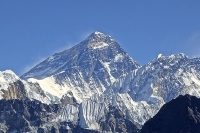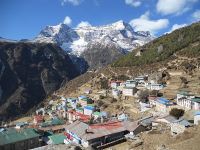The most popular region for trekking in Nepal, the Annapurna region passes through some of the most spectacular scenery in the country. It has deep valleys, ancient stone settlements, Tibetan culture, Buddhist temples and monasteries, and mountains over 22,966 feet (7,000m) tall.Excellent lodges line the main routes of the Annapurna Circuit, the Annapurna Sanctuary, and the Jomsom trek to Muktinath. The Annapurna Circuit is one of the most walked treks in the country and is one of the most exceptional routes on earth, crossing Thorong-La pass at 17,769 feet (5,416m) and requiring about three weeks to complete.The Sanctuary requires about 10 days and is a direct route straight to the heart of the Himalayas, where tremendous sheer-walled peaks of 19,685 to 26,247 feet (6,000 to 8,000m) encircle the reverent trekker at the Annapurna Base Camp.Easily accessible via a short flight from Pokhara or Kathmandu, Jomsom is a town situated between two gigantic mountains in the Kali Gandaki Valley, at the bottom of the world's deepest gorge.From Jomsom, there are options to walk in either direction along the Annapurna Circuit. The trek to the holy shrine at Muktinath is very popular and follows the ancient trade and pilgrimage route across the Himalayas.

The sight and challenge of the highest mountain the world draws trekkers and mountaineers from across the world. They set out to explore the Sagarmartha National Park in the northeast of Nepal, even if not attempting an ascent.The Sagarmartha National Park is a UNESCO World Heritage Site, containing a mixed terrain of deep gorges, glaciers, and rocky landscapes. Home to some interesting fauna and flora, the alpine vegetation nevertheless gives way to bare rock and snow as the altitude increases.Most trekkers fly to the airstrip at Lukla at an altitude of 9,350 feet (2,850m) from where the trek begins to Everest Base Camp. From Lukla, the trail winds up the Dudhkoshi River Valley to the famous Sherpa village of Namche Bazaar.Above Namche, travellers will find the smaller traditional villages of Khunde and Khumjung, and across the canyon from Khunde is the fascinating Tengboche Monastery, one of the highlights of the area. Visitors will find lodges and campsites at the monastery.By flying in and out, the trek requires about two weeks. It's also possible to walk in but this requires much more time. Multi-day treks in the region are a wonderful opportunity to observe and participate in the daily life of the Sherpa people, and of course, the views and landscapes are breath-taking.

One of the most popular stops on any Himalayan trek, Namche Bazaar makes a good rest stop on the climb to Mount Everest base camp. Many trekkers spend at least a day there to acclimatise to the high altitude, with two days being better.Namche is the unofficial capital of the Khumbu region. It started out as a trading post, a place where locals met to barter and exchange goods. Despite its popularity as a stop for trekkers, it has remained a small settlement.The town has a variety of accommodation, restaurants, teahouses, and shops that mostly sell supplies. From just above the village, trekkers will get their first view of Mount Everest itself. The main attractions in Namche Bazaar include the weekly market at the centre of the village and the small Namche Monastery.The Sagarmatha National Park Visitors Centre is located in the top end of the village and offers information on wildlife in the area. The Museum of Sherpa Life, located just above the village, is worth a visit while the Museum of Local Medicinal Plants is interesting for those curious about traditional healing techniques.As Namche is the only place in the region to offer money changing facilities (besides Lukla), trekkers should ensure that they have sufficient cash for the remainder of their journey before leaving.

Travel Guide powered by Word Travels, copyright © 2023 Globe Media Ltd. By its very nature information in this travel guide is subject to change at short notice and travellers are urged to verify information on which they're relying with the relevant authorities. Neither Globe Media Ltd nor Travel Vogue can accept any responsibility for any loss or inconvenience to any person as a result of information contained above.